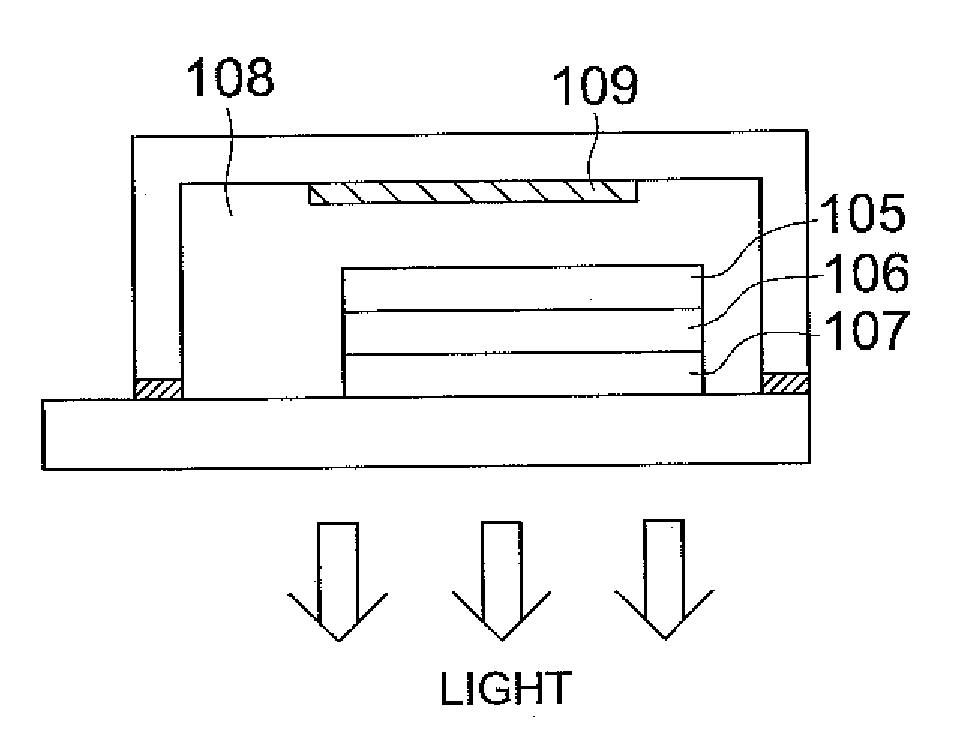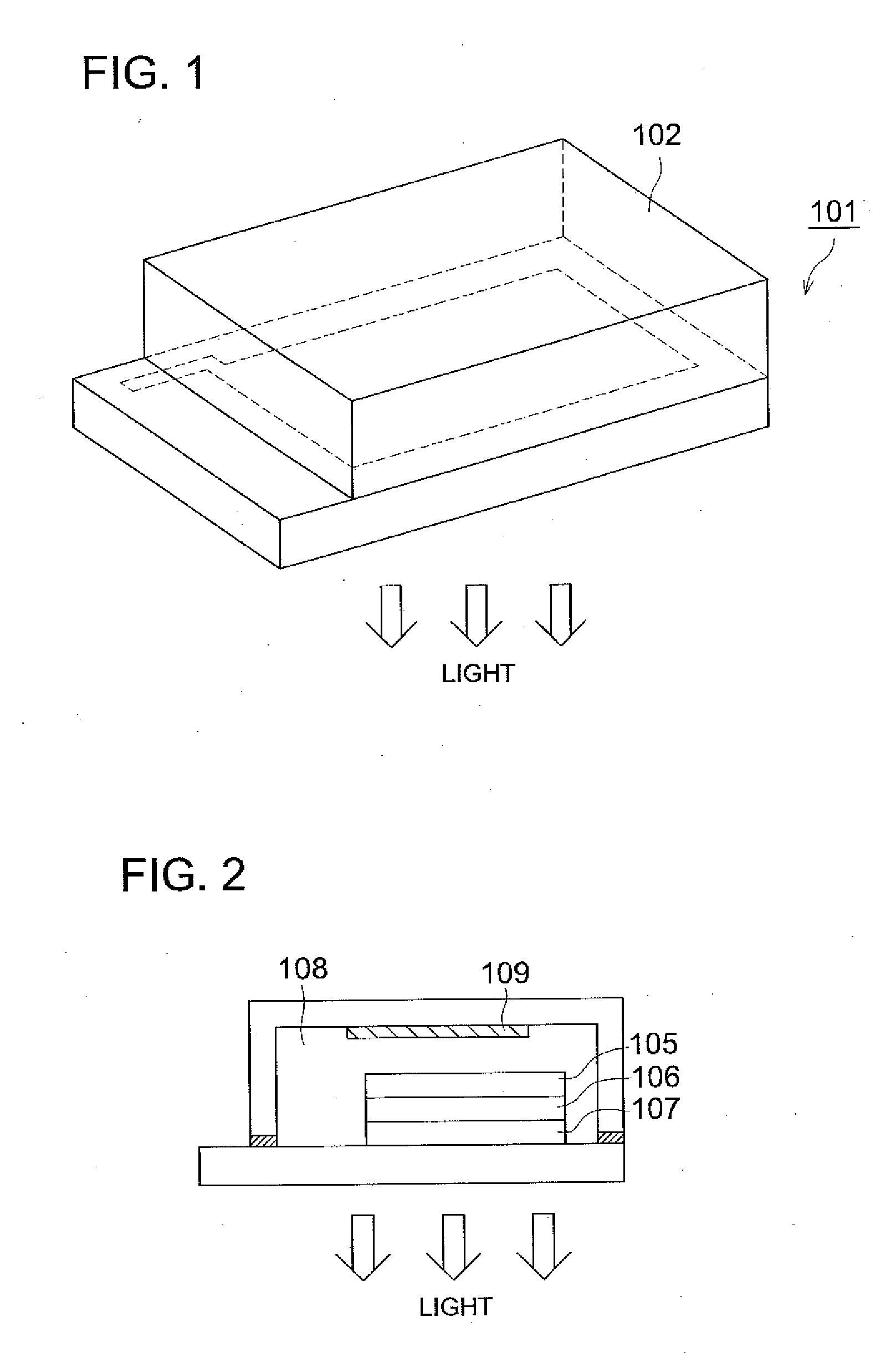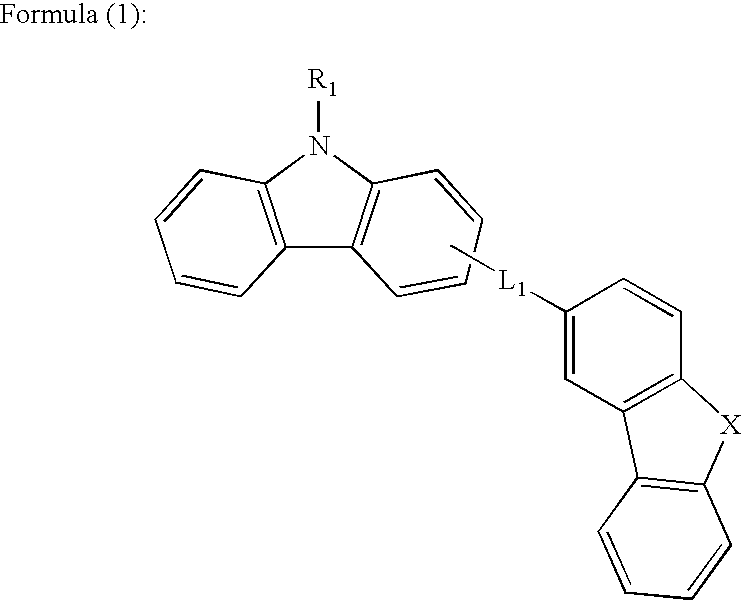Organic Electroluminescence Element Material, Organic Electroluminescence Element, Display Device and Lighting Apparatus
- Summary
- Abstract
- Description
- Claims
- Application Information
AI Technical Summary
Benefits of technology
Problems solved by technology
Method used
Image
Examples
example 1
Preparation of Organic EL Elements 1-1
[0211]A pattern was formed on a substrate composed of a glass plate of 100 mm×100 mm×1.1 mm and a 100 nm ITO (indium tin oxide) layer (NA45: manufactured by NH Technoglass Co., Ltd.) as an anode. Then the resulting transparent substrate, having the above ITO transparent electrode, was subjected to ultrasonic cleaning in iso-propylalcohol, dried with a dry nitrogen gas, and then subjected to UV-ozone cleaning for 5 minutes. Thus obtained transparent substrate was fixed to a substrate holder of a commercially available vacuum deposition apparatus. Further, 200 mg of α-NPD was placed in a first resistive heating molybdenum boat, 200 mg of CBP, as a host compound, was placed in a second resistive heating molybdenum boat, 200 mg of BCP was placed in a third resistive heating molybdenum boat, 100 mg of illustrated compound 1-1 was placed in a fourth resistive heating molybdenum boat, and 200 mg of Alq3 was placed in a fifth resistive heating molybdenu...
example 2
Preparation of Organic EL Elements 2-1
[0226]A pattern was formed on a substrate composed of a glass plate of 100 mm×100 mm×1.1 mm and a 100 nm ITO (indium tin oxide) layer (NA45: manufactured by NH Technoglass Co., Ltd.) as an anode. Then the resulting transparent substrate, having the above ITO transparent electrode, was subjected to ultrasonic cleaning in iso-propylalcohol, dried with a dry nitrogen gas, and then subjected to UV-ozone cleaning for 5 minutes. Thus obtained transparent substrate was fixed to a substrate holder of a commercially available vacuum deposition apparatus. Further, 200 mg of α-NPD was placed in a first resistive heating molybdenum boat, 100 mg of CBP as a host compound was placed in a second resistive heating molybdenum boat, 200 mg of BAlq was placed in a third resistive heating molybdenum boat, 100 mg of Ir(ppy)3 was placed in a fourth resistive heating molybdenum boat, and 200 mg of Alq3 was placed in a fifth resistive heating molybdenum boat, and the r...
example 3
Preparation of Organic EL Element 3-1
[0233]A pattern was formed on a substrate composed of a glass plate of 100 mm×100 mm×1.1 mm and a 100 nm ITO (indium tin oxide) layer (NA45: manufactured by NH Technoglass Co., Ltd.) as an anode. Then the resulting transparent substrate, having the above ITO transparent electrode, was subjected to ultrasonic cleaning in iso-propylalcohol, dried with a dry nitrogen gas, and then subjected to UV-ozone cleaning for 5 minutes. Thus obtained transparent substrate was fixed to a substrate holder of a commercially available vacuum deposition apparatus. Further, 200 mg of α-NPD was placed in a first resistive heating molybdenum boat, 100 mg of m-CP, as an electron blocking compound, was placed in a second resistive heating molybdenum boat, 200 mg of CBP, as a host compound was placed in a third resistive heating molybdenum boat, 200 mg of BAlq was placed in a fourth resistive heating molybdenum boat, 100 mg of Light emitting dopant 1-1 was placed in a fi...
PUM
| Property | Measurement | Unit |
|---|---|---|
| Nanoscale particle size | aaaaa | aaaaa |
| Volume | aaaaa | aaaaa |
| Angle | aaaaa | aaaaa |
Abstract
Description
Claims
Application Information
 Login to View More
Login to View More - R&D
- Intellectual Property
- Life Sciences
- Materials
- Tech Scout
- Unparalleled Data Quality
- Higher Quality Content
- 60% Fewer Hallucinations
Browse by: Latest US Patents, China's latest patents, Technical Efficacy Thesaurus, Application Domain, Technology Topic, Popular Technical Reports.
© 2025 PatSnap. All rights reserved.Legal|Privacy policy|Modern Slavery Act Transparency Statement|Sitemap|About US| Contact US: help@patsnap.com



